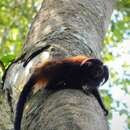en
names in breadcrumbs


Perception Channels: tactile ; chemical
L. chrysopygus is listed as one of the world's rarest mammals. It is estimated that only about 700 are still living in both the wild and captivity. (Massicot 2001)
US Federal List: threatened
CITES: appendix i
IUCN Red List of Threatened Species: endangered
There are no negative effects of lion tamarins on humans.
L. chrysopygus is periodically captured and sold in Brazil as pets, though this has a negative impact on this imperiled species. The charismatic quality of lion tamarins makes them excellent candidates for ecotourism activities. (Beacham 1998)
Positive Impacts: pet trade ; ecotourism
Golden-rumped lion tamarins may be important as seed dispersers in the ecosystems in which they live.
Leontopithecus chrysopygus eats mainly insects and fruits. When they are able to catch them, L. chrysopygus will eat small lizards, small birds, bird eggs, and small vertebrates. (Massicot 2001)
Animal Foods: birds; reptiles; eggs; insects
Plant Foods: fruit
Primary Diet: omnivore
Golden-rumped lion tamarins (Leontopithecus chrysopygus) at one time inhabited the vast tropical forest in the Central and Western portions of the state of Sao Paulo, Brazil. Now L. chrysopygus is limited to only two areas. One is the 375 square kilometer Morro do Diabo State Forest Reserve in southwesten Sao Paulo. The other is the Caiteus Reserve, a 23 square kilometer reserve in central Sao Paulo. (Beacham 1998)
Biogeographic Regions: neotropical (Native )
Leontopithecus chrysopygus lives primarily in semideciduous forest of Sao Paulo. But it has also been know to occupy swamp forest and macega, a forest made up of mainly small bush-like trees. In these forests, L. chrysopygus lives approximately 3 to 12 meters above the ground, rarely going to the forest floor, giving it the classification of arboreal.
Range elevation: 0 to 700 m.
Habitat Regions: tropical ; terrestrial
Terrestrial Biomes: forest ; rainforest
Leontopithecus chrysopygus in the wild will live for approximately ten years. In captivity the longest lived golden-rumped lion tamarin lived for 28 years. (Nowak 1999)
Average lifespan
Status: wild: 10 years.
Range lifespan
Status: captivity: 28 (high) years.
Average lifespan
Status: captivity: 17.9 years.
L. chrysopygus is covered almost completely in silky, dense black hair. The only place this differs is in the hind quarters. The thighs, buttocks, and base of the tail are colored a reddish-brown. This is what gives the animal its common name, golden-rumped lion tamarin. The face of L. chrysopygus is not haired, as well as the hands and feet, these are colored dark gray to black. The hind limbs are generally longer than the forelimbs and the tail is not prehensile. All digits have a pointed sickle shaped nail, which is used for gripping trees, except the big toe which has a flat nail. The dental formula is as follows, 2/2 incisors, 1/1 canines, 3/3 premolars, 2/2 molars. Body length in L. chrysopygus is between 20 cm and 33.5 cm, tail length is usually 31.5 to 40 cm, and mass ranges from 300 to 700 g. (Beacham 1998; Nowak 1999; Wolters 1990)
Range mass: 300 to 700 g.
Average mass: 572.5 g.
Range length: 20 to 33.5 cm.
Other Physical Features: endothermic ; bilateral symmetry
The main predators of golden-rumped lion tamarins are small cats, birds of prey, and snakes. They avoid predation by being part of a social organization, so that more individuals are alert to potential dangers and will give warning signals to other members of their troupe. (Wolters 1990)
Known Predators:
Most cases have found L. chrysopygus to be monogamous when mating but there has been some polyandy observed in certain populations. In populations where there is more than one adult male per social group the female may mate with several males to confuse the males as to paternity of her young. This causes males to provide assistance in the care of offspring that may be their own.
Mating System: monogamous ; polyandrous
Golden-rumped lion tamarins give birth most frequently to twins, though triplets and quadruplets have been reported. In other species of lion tamarin, gestation lasts from 125 to 132 days. Lion tamarins give birth during the rainy season, usually from September through March.
Breeding season: Breeding occurs from September through March, the wet season..
Range number of offspring: 1 to 4.
Average number of offspring: 2.
Range gestation period: 125 to 132 days.
Range weaning age: 2 to 3 months.
Range age at sexual or reproductive maturity (female): 16 to 24 months.
Range age at sexual or reproductive maturity (male): 16 to 24 months.
Key Reproductive Features: gonochoric/gonochoristic/dioecious (sexes separate); sexual
Both male and female golden-rumped lion tamarins aid in the rearing of offspring. The young are born well-furred and with their eyes open, but are entirely dependent on adults for their care. For the first 2 to 3 weeks newborns stay primarily with the mother. After three weeks the father will carry the young for much of the day, bringing them to their mother every 2 to 3 hours for feeding. The offspring are weaned after 2 to 3 months but usually don't leave the family group until they reach sexual maturity, at 16 to 24 months. (Nowak 1999)
Parental Investment: precocial ; pre-fertilization (Provisioning, Protecting: Female); pre-hatching/birth (Provisioning: Female, Protecting: Female); pre-weaning/fledging (Provisioning: Female, Protecting: Male, Female); pre-independence (Protecting: Male, Female); post-independence association with parents; extended period of juvenile learning